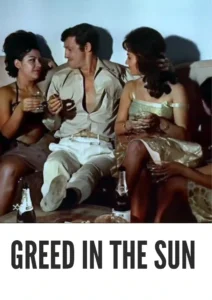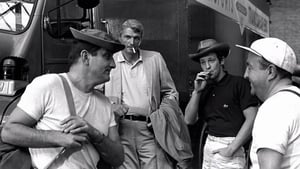Video Sources 0 Views

Synopsis

Get ready for a scorching adventure with Greed in the Sun, a French-Italian action classic from 1964, now brilliantly colorized to bring the Sahara Desert to life like never before. Directed by Henri Verneuil and featuring iconic actors Jean-Paul Belmondo and Lino Ventura, this film delivers a thrilling mix of suspense, comedy, and high-speed chases. Perfect for fans of classic adventure films and those seeking a sun-drenched thrill ride, this HD download offers a visually stunning and action-packed experience. Also known as Cent mille dollars au soleil, this is an adventure you won’t want to miss!
Greed in the Sun follows the intense journey of truck drivers in the scorching Sahara Desert. When a valuable truck is hijacked, the company dispatches its best driver, Marec, to retrieve it. Along the way, Marec is partnered with Steiner, a mysterious newcomer with a hidden past.
As they navigate the treacherous landscape, they encounter Rocco, the cunning thief, and his alluring girlfriend, Pepa. The chase intensifies, filled with daring stunts, close calls, and unexpected betrayals. The film explores themes of greed, trust, and survival as the characters battle both the harsh environment and each other in pursuit of fortune. The story culminates in a dramatic showdown, where alliances are tested and the true value of loyalty is revealed.
The film features a stellar international cast, each bringing their unique talents to the screen:
-
Jean-Paul Belmondo as Rocco
-
Lino Ventura as Hervé Marec
-
Reginald Kernan as John Steiner
-
Bernard Blier as Mitch-Mitch
-
Andréa Parisy as Pepa
-
Gert Fröbe as Castigliano
-
Anne-Marie Coffinet as Angèle
Greed in the Sun is a thrilling blend of adventure, action, and comedy, set against the backdrop of the vast Sahara Desert. It is a classic road movie filled with high-speed chases, intense confrontations, and plenty of humor.
Released in 1964, Greed in the Sun reflects the popularity of co-produced European films during the 1960s. This era saw a surge in collaborations between French and Italian filmmakers, resulting in a diverse range of genres and styles. Greed in the Sun exemplifies this trend, combining French sensibilities with Italian flair to create a captivating and commercially successful film. Its themes of adventure and pursuit resonated with audiences worldwide, solidifying its place as a classic of its time.
This colorized version of Greed in the Sun has been meticulously restored using state-of-the-art digital technology, enhancing the visual experience while honoring the film’s original aesthetic. The colorization process involved a detailed analysis of the grayscale tones, with careful consideration given to the lighting and environment of each scene. Advanced algorithms were used to select appropriate colors, bringing new depth and vibrancy to the characters and landscapes. This painstaking process breathes new life into the film, making it even more appealing to modern audiences while preserving its classic charm.
-
: Henri Verneuil
-
: Henri Verneuil, Michel Audiard, Marcel Jullian
-
: Claude Veillot
-
: Marcel Grignon
-
: A. C. Bale
-
: Co-production France-Italy
-
: Wardour Films (UK)
-
: 130 minutes
-
: MP4
-
: HD (1080p)
-
: Compatible with most devices, including smartphones, tablets, computers, and smart TVs.
Greed in the Sun (1964) is celebrated for its thrilling action sequences, memorable performances, and stunning cinematography. It remains a beloved classic, praised for its ability to transport audiences to the heart of the Sahara Desert and deliver an unforgettable cinematic experience. As a prime example of French-Italian collaboration, Greed in the Sun continues to captivate and entertain viewers of all ages.
-
: What is Greed in the Sun about?
-
A: Greed in the Sun is an action-packed adventure film about a group of truck drivers in the Sahara Desert who become embroiled in a high-stakes chase after a valuable truck is hijacked.
-
-
: Is Greed in the Sun (1964) a well-known film?
-
A: Greed in the Sun is a recognized classic, celebrated for its thrilling action and iconic performances.
-
-
: Is this version of Greed in the Sun colorized?
-
A: Yes, this version has been professionally colorized to enhance the viewing experience.
-
-
: What makes Greed in the Sun interesting for classic film fans?
-
A: Greed in the Sun offers a unique blend of adventure, action, and comedy, set against the stunning backdrop of the Sahara Desert.
-
-
: What is the download format?
-
A: The download format is MP4, which is compatible with most devices.
-
-
: What resolution is the download?
-
A: The resolution is HD (1080p), providing a high-quality viewing experience.
-
Watch Greed in the Sun Today!













